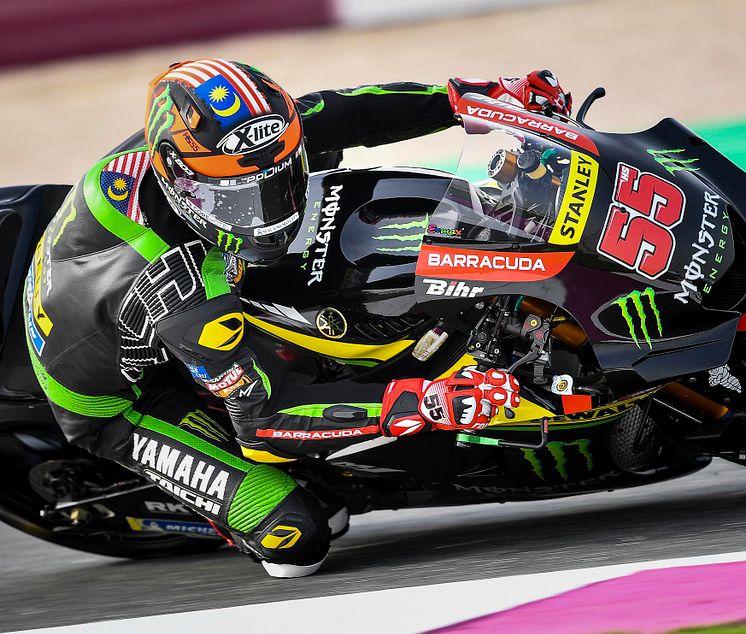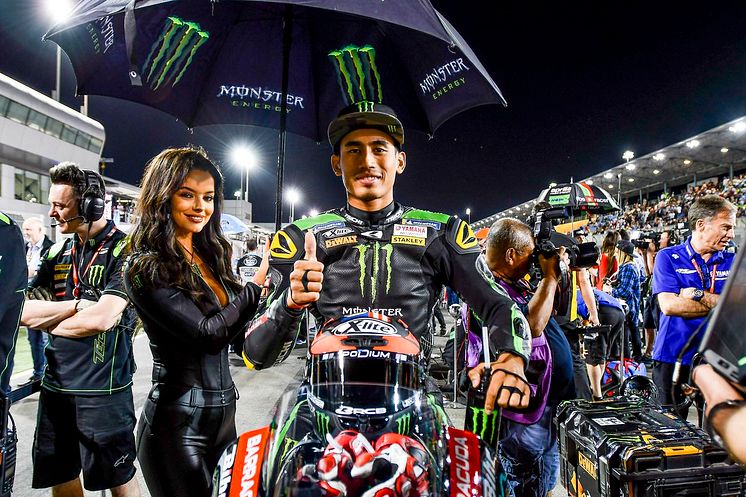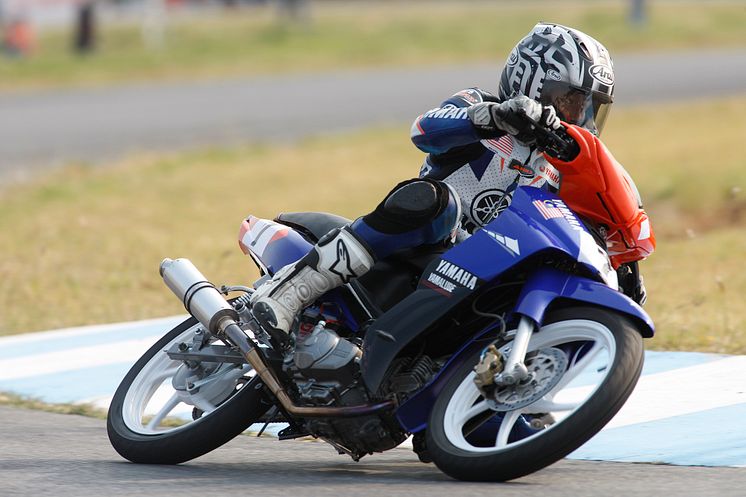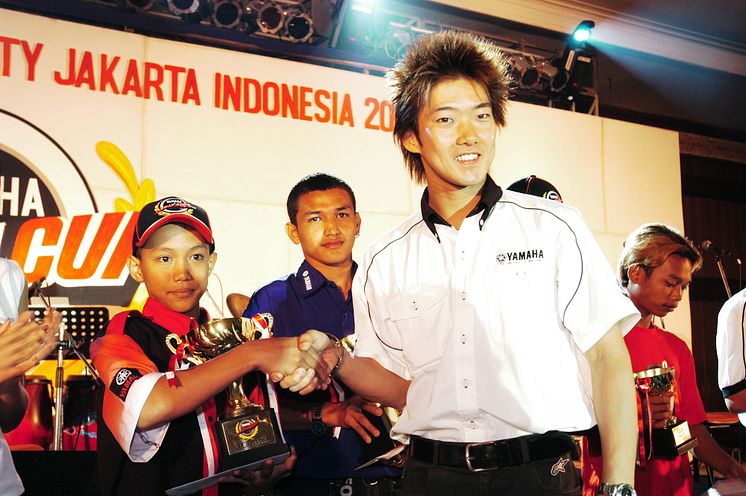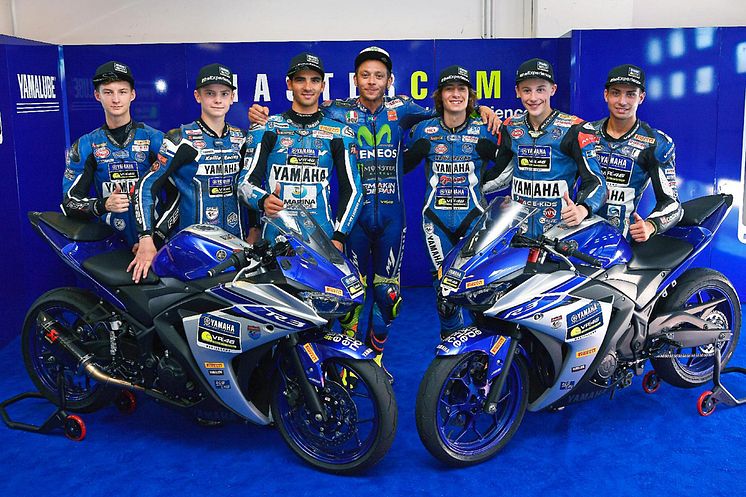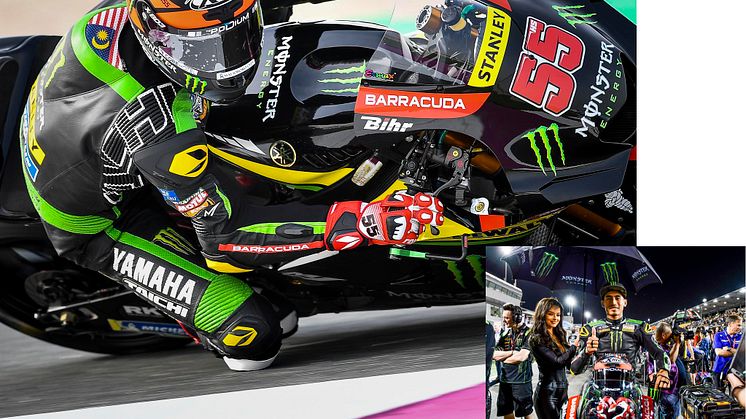
News -
Preparing the Next Generation of Racing Stars Yamaha Motor Newsletter(Mar.30, 2018 No.63)
It’s spring, which means the 2018 motorsports season has finally begun. Yamaha’s riders and teams are set to challenge once again for titles in road racing and motocross, from national and regional series to world championships.
The riders in particular carry the weight of their fan’s expectations and fly the banner for their teams, and since they are chosen from among a wide field of prospects, they are also often seen as heroes. The scenes of them locked in on-track battles and the race victories they secure serve to create new Kando* and add greater luster to the Yamaha brand.
Yamaha has been continuously active in motorsports since its founding and is constantly working to discover and develop young talent in order to pass on its racing tradition and passion to the next generation. In this issue, we introduce some of those efforts in motorcycle road racing and its pinnacle class of MotoGP.
*Kando is a Japanese word for the simultaneous feelings of deep satisfaction and intense excitement that we experience when we encounter something of exceptional value.
To the Premier Class: A Hero Who Once Raced Underbones
In mid-February, one month before the MotoGP season-opener in Qatar, Monster Yamaha Tech3 team manager Hervé Poncharal chose 23-year-old Malaysian rider Hafizh Syahrin to fill-in at the official test in Buriram, Thailand. He commented on the prospective rookie’s performance on the MotoGP.com website.
“It was a good surprise! You have to keep in mind that Hafizh was absolutely unprepared [for riding in MotoGP], that he was heading for his Moto2 project. [He took last year’s bike] for these three days of testing and finished only 1.7 seconds from the best laptime.”
Just a few days later he would be officially welcomed to the team’s lineup to replace Jonas Folger, who is out for the season. “We had to give him a tough task during the three days of testing in Buriram. In the end, he did a tremendous job; he fulfilled the mission. I know this is going to be something historical, because it’s the first time that a Malaysian rider is racing a full season on a MotoGP bike and we know how popular our sport in this part of the world is,” said Poncharal.
In Southeast Asian motorcycle markets, 100–150cc underbone machines are commonplace, and local/club and national races using these bikes has long been popular in countries like Indonesia, Malaysia and Thailand. Adding in China, India, Japan, the Philippines and other countries, the Asia Road Racing Championship (ARRC) was established in 1996, holding races in each country.
The series is currently comprised of the SuperSports 600cc (SS600) class at the top, with the Asia Production 250cc (AP250) class, Underbone 150cc (UB150) class and other class races below it. Recently, the number of riders who have honed their skills in this series and made the jump to racing in Europe and other international series is on the rise.
Syahrin’s selection for the Tech3 team is a brilliant achievement that also speaks volumes of the surge in popularity of road racing seen in ASEAN countries. He became the first rider to go from underbone racing to achieving every rider’s dream of competing in MotoGP.
ASEAN Cup: Tapping into Southeast Asia’s Talent
Yamaha and Southeast Asia have a long history together. From the early 1960s when Yamaha was making its first forays overseas, factory teams would be sent to participate in major races in countries like Malaysia and Singapore with the goals of branding and boosting motorcycle sales. The TD-1 production racer was also introduced to help promote the spread and popularization of road racing.
Starting in the 1980s, Yamaha’s group companies, local distributors and dealerships took the lead and began running initiatives in their respective countries, such as hosting one-make Yamaha Cup Races, setting up the Yamaha Riding Academy program to improve rider skills, supporting domestic championships and even providing training for instructors, all aimed at increasing the number of racers and raising the level of competition.
The Yamaha ASEAN Cup Race was also one of those initiatives, a one-make race that began in 2003 and brought together riders that won their countries’ respective qualifiers to compete. It was an event where riders and mechanics from various ASEAN countries came together and tested their skills against each other using the same spec machines (mainly underbones) to learn and grow. Winners that cleared a certain set of conditions would receive Yamaha support like rider and mechanic training and the lending of racebikes with an eye on helping them eventually step up to the ARRC, the All Japan Road Race Championship or even world championships.
The first heroes the Yamaha ASEAN Cup Race produced include Indonesian rider Doni Tata Pradita and Thai rider Decha Kraisart. Pradita won the very first ASEAN Cup event in the Novice Class when he was 12 and then built up experience in Indonesia and Japan before making his GP debut with a wildcard in the 250cc World Championship (currently the Moto2 class) at the age of 17. Kraisart entered the Expert Class of the Cup from its first to fifth event and achieved excellent results before switching from an underbone to a YZF-R6 and entered the ARRC’s SS600 class and the ST600 class of the All Japan Championship, taking three titles in the process.
Syahrin is also a graduate like Pradita and Kraisart, winning the Novice Class at the 6th ASEAN Cup when he was 14. After gaining experience in Moto2 he has returned to Yamaha. Will he become the shining star of Southeast Asia? It will be fascinating to see how he progresses as a rookie over the long, 19-round MotoGP season.
 With the ASEAN Cup, Yamaha worked to elevate the level of racing overall with riding clinics put on by top riders, providing support for mechanics and more.
With the ASEAN Cup, Yamaha worked to elevate the level of racing overall with riding clinics put on by top riders, providing support for mechanics and more.
 Syahrin won the Yamaha ASEAN Cup Race in 2009 and has now fulfilled the dream he spoke of after his win: “I want to someday become a MotoGP rider.”
Syahrin won the Yamaha ASEAN Cup Race in 2009 and has now fulfilled the dream he spoke of after his win: “I want to someday become a MotoGP rider.”
Training the Next Generation: Finding the World’s Next Rossi
While the ASEAN Cup showed steady results with rider development, Yamaha reaffirmed its global motorsports strategy in 2015—its 60th anniversary. As part of that, Yamaha began to create a new roadmap for ambitious young riders to reach the world level.
The first step on that roadmap is the ARRC. To facilitate the switch from underbones to motorcycles, Yamaha pushed for the AP250 class to be established with 250cc supersport bikes eligible for entry. And from 2013, the ASEAN Cup included a class using the YZF-R15 and then the YZF-R25 the following year to take this effort across all of Southeast Asia.
Then in 2015, Yamaha positioned racing in Japan as its central base for developing racing technology and personnel and began a global personnel development program in coordination with its subsidiaries throughout Southeast Asia. This took form with 6 teams from Australia, Hong Kong, Indonesia, South Korea and Thailand fielding 13 riders on R25s.
The following year, an official SS600 Yamaha team was also put together to function as an objective for riders in the lower classes to aim for. In addition, the Master Camp was created in cooperation with the VR46 Riders Academy, Valentino Rossi’s training program for young Italian racers. Held for about a week at the Academy’s training facilities and at the Misano World Circuit Marco Simoncelli, the Academy’s staff and regular riders provide instruction to the lucky participants.
Asian riders racing in the AP250 class were selected to participate in the first and second editions of the Camp in 2016 and the experience gave them renewed determination to aim for the world level and make their dreams a reality.
The first of these attendees to really stand out was Thai rider Apiwat Wongthananon. In 2016, the year he joined the Master Camp, he won 8 of 12 races in the AP250 class’ six rounds to win the title. He went on to compete in the CEV Moto3 Junior World Championship in 2017 and also made a wildcard appearance at the ARRC season finale that year, where he took a stunning double victory in the SS600 class. He is again competing in the CEV Moto3 Junior World Championship in 2018 where he hopes to lift the championship title. Another Master Camp attendee, Indonesian rider Galang Hendra Pratama, contested two rounds of the 2017 World Supersport 300 Championship (WSSP300) as a wildcard and took his—and Indonesia’s—first world championship win at the final round of the season. In 2018 he will make the jump from Southeast Asia to the world level, as he contests a full season in WSSP300.
“Yamaha engages in motorsports across the world to raise the value of our brand, acquire technology to then incorporate our products and promote the healthy spread of racing culture. A vital part of these efforts is to find a young rider to inherit the Yamaha racing spirit from Valentino Rossi and Maverick Viñales, and train and develop him or her ourselves,” says Keitaro Horikoshi, the General Manager of Yamaha’s Motor Sports Strategy Division.
“For example, if we are able to find and nurture a champion from Southeast Asia, which is the biggest motorcycle market in the world, it would be a fantastic feat the likes of which we’ve never seen. Of course, it’s no easy task to best the talent from well-established markets like Europe and North America, but that makes it all the more a uniquely Yamaha challenge.”
For Syahrin, having finally secured a dream chance in 2018, how far will he go? And who will follow the footsteps he is leaving? This exciting story has only just begun.
 Riders from a wider area were chosen for the Master Camp in 2017, including Europe, North America, Oceania and South America. Of them, Italian Alfonso Coppola will be moving up from WSSP300 to the World Supersport Championship in 2018.
Riders from a wider area were chosen for the Master Camp in 2017, including Europe, North America, Oceania and South America. Of them, Italian Alfonso Coppola will be moving up from WSSP300 to the World Supersport Championship in 2018.
|
Message from the Editor Hello, readers! I’m Naoto Horie with Yamaha’s PR Group and will be in charge of this newsletter and its content from this issue onward. To think that a young Hafizh Syahrin once raced in the Yamaha ASEAN Cup Races and now races in the premier MotoGP class with the Monster Yamaha Tech3 team! I spent nearly 10 years working in the ASEAN region, so his achievement is both very exciting and deeply moving for me personally. It is my hope that many more young riders from the region will continue to dream of racing in MotoGP and make it their goal to follow in Syahrin’s footsteps. Naoto Horie |
